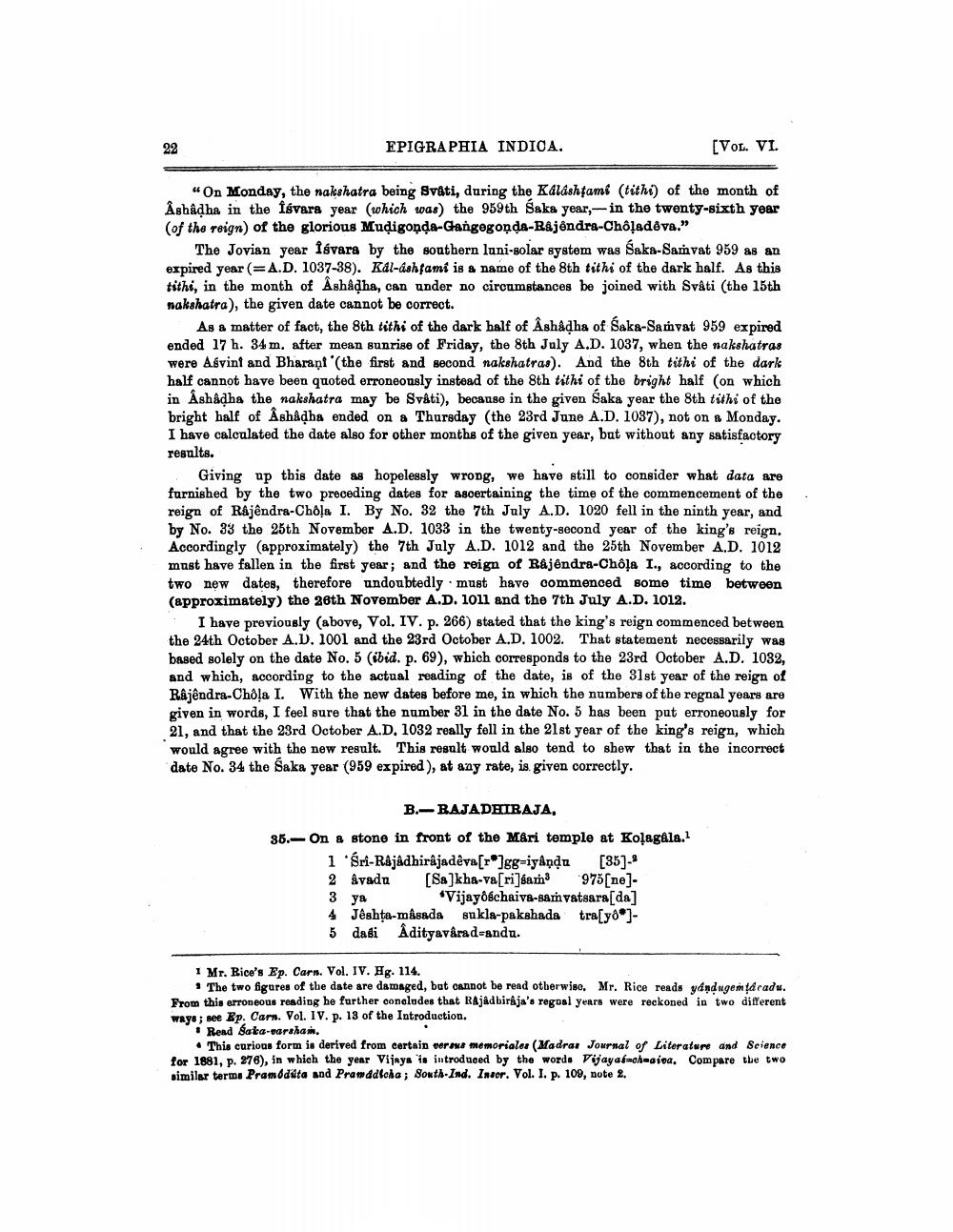________________
EPIGRAPHIA INDICA.
[Vol. VI.
“On Monday, the nakshatra being Sväti, during the Kalashtami (tith) of the month of Ashadha in the Isvara year (which was) the 959th Saka year, in the twenty-sixth year (of the reign) of the glorious Mudigonda-Gangogoņda-Rajendra-Chôļadēva."
The Jovian year Isvara by the southern lani-solar system was Saka-Samvat 959 as an expired year (=A.D. 1037-38). Kal-ashtami is a name of the 8th tithi of the dark half. As this tithi, in the month of Ashådha, can under no circumstances be joined with Svati (the 15th nakshatra), the given date cannot be correct.
As a matter of fact, the 8th tithi of the dark half of Ash&dha of Saka-Samvat 959 expired ended 17 h. 34 m, after mean sunrise of Friday, the 8th July A.D. 1037, when the nakshatras were Asvint and Bharani '(the first and second nakshatras). And the 8th tithi of the dark half cannot have been quoted erroneously instead of the 8th tithi of the bright half (on which in Åshadha the nakshatra may be Svati), because in the given Saka year the 8th tithi of the bright half of Ashådha ended on a Thursday (the 23rd June A.D. 1037), not on a Monday. I have calculated the date also for other months of the given year, but without any satisfactory results.
Giving up this date & hopelessly wrong, we have still to consider what data are furnished by the two preceding dates for ascertaining the time of the commencement of the reign of Rajendra-Chôļa I. By No. 32 the 7th July A.D. 1020 fell in the ninth year, and by No. 33 the 25th November A.D. 1033 in the twenty-second year of the king's reign. Accordingly (approximately) the 7th July A.D. 1012 and the 25th November A.D. 1012 must have fallen in the first year; and the reign of Rajendra-Chola I., according to the two new dates, therefore undoubtedly must have commenced some time between (approximately) the 28th November A.D. 1011 and the 7th July A.D. 1012.
I have previously (above, Vol. IV. p. 266) stated that the king's reign commenced between the 24th October A.D. 1001 and the 23rd October A.D. 1002. That statement necessarily was based solely on the date No. 5 (ibid. p. 69), which corresponds to the 23rd October A.D. 1032, and which, according to the actual reading of the date, is of the 31st year of the reign of Rajendra-Chola I. With the new dates before me, in which the numbers of the regnal years are given in words, I feel sure that the number 31 in the date No. 5 has been pat erroneously for 21, and that the 23rd October A.D. 1032 really fell in the 21st year of the king's reign, which would agree with the new result. This result would also tend to shew that in the incorrect date No. 34 the Saka year (959 expired), at any rate, is given correctly.
B.-BAJADHIRAJA, 35.-- On a stone in front of the Mari temple at Koļagala.
1 SM-Râjâdbirâjadeva[*]gg-iyându (35)-> 2 @vada [Sa]kha-va[rijam3 975[ne]. 3 ya
Vijayokchaiva-samvatsara[da] 4 Jeshta-mêsada sukla-pakshada trasyo®]5 dasi Adityavárad-andu.
1 Mr. Rice's Ep. Carn. Vol. IV. Hg. 114.
The two figures of the date are damaged, but cannot be read otherwiso. Mr. Rice reads yandugem tá cadu. From this erroneous reading he further concludes that Rajadbirkja's regoal years were reckoned in two different ways ; see Ep. Carn. Vol. IV. p. 13 of the Introduction.
* Read Sata-warshan.
This curious form is derived from certain berpus memoriales (Madral Journal of Literature and Science for 1881, p. 276), in which the year Vijays is introduced by the words Vijayafachaioa. Compare the two similar terma Pramoddta and Prawddlcha; South-Ind. Insor. Vol. I. p. 109, note 2.




